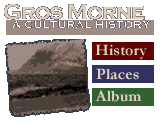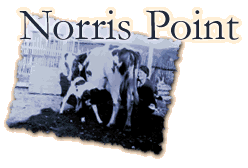
 |
Norris Point 1890 |
| Clarke's Wharf
Norris Point Unknown |
 |
 |
Church of England Bell Tower Unknown |
| Church of
England Unknown |
 |
 |
Building of the Cottage
Hospital in Norris Point 1939 |
| Bonne Bay
Cottage Hospital 1940 |
 |
 |
Milking a Cow 1930 |
| Celebrations
during the Coronation of Queen Elizabeth II 1952 |
 |
 |
Norris Point Waterfront 1939 |
| Boat-Coastal
Steamer Unknown |
 |
 |
Lady Walwyn's visit to Norris
Point 1942 |
| Old Elementary
School Unknown |
 |

On the west Coast of Newfoundland, half way between Cape Norman to the north and Cape Ray to the south, lies Bonne Bay. Bonne Bay is approximately eighty kilometres by water from the city of Corner Brook and approximately one hundred and forty kilometres by road. This picturesque bay with several small communities nestled in its coves stretches inland for a distance of twelve miles. Rocky Harbour is located at its entrance and Lomond is at its head. Norris Point is situated about half way in the bay on the northern side.
The terrain is very mountainous in this area because the Long Range Mountains of the Great Northern Peninsula stretch to the ocean. What was once believed to be the highest mountain in Newfoundland (actually the second highest), Gros Morne, towers at the back of Norris Point. The settlements in the area have been built on patches of fairly level ground but the remainder of the land is composed of high mountains with shear-face cliffs which drop vertically to the waters of Bonne Bay.
Norris Point is not a large settlement according to our modern standards but it is fairly large for a Newfoundland outport. The Dominion Bureau of Statistics carried out a survey in 1967 which revealed that Norris Point had a population of 885 people living in 168 houses. During the 1970's Norris Point grew with the arrival of families from resettled communities displaced by the development of Gros Morne National Park. In 1976 the population jumped to 1065. Today the population stands at 1010 and there are around 270 houses. The fact that many young people move away from the area upon graduating (or dropping out) from the high school is one of the major reasons for the decline.
Neddie Norris was one of the first settlers of Norris Point. Much of the research about Neddie Norris indicates that he, his wife and two children lived in this area around 1789-1790. Some reports claim that Norris arrived sometime before 1822, others say that he arrived in 1810, but researchers at the History Department of Memorial University of Newfoundland indicate that Norris was the first settler of Bonne Bay before 1800. His arrival and apparent disappearance appears to be clouded with mystery and superstition. One popular story has it that Norris and an old Frenchman named Jacques were having a party and Norris went out the door and was never seen again. Another story suggest that Neddie and his family disappeared and that Norris' body is buried in the field below the old "Cellar" across from what is now the ferry ramp.
History is not quite clear when and if Neddie and his family left Norris Point but reports indicate that he and his family were not there when the first permanent settlers arrived. At any rate, despite accurate records Neddie Norris had the honour of having Neddies Harbour and Norris Point named after him. Somehow his two names stuck and are perhaps the only things he left behind.
In 1833, William "Billy" Humber and his wife Charlotte left Dorset, England, where he had heard from the English fishing ships which inhabited the waters of the West Coast of Newfoundland of the quantities of fish in Bonne Bay. Even though Norris Point was settled earlier by Neddie Norris, the Humber's have the distinct honour of being the first permanent settlers of this community. On February 3, 1834 Charlotte gave birth to a son James, who is believed to be the first baby of European descent born in Norris Point. Billy, Charlotte and their son James are believed to have been the only residents of Norris Point for the next two decades.
In 1858, George and Susannah Harding, their brother-in-law Matthew Smith and wife Frances and other members of his family were living on the south coast of Newfoundland at Burnt Island. They were interested in the Labrador fishery so to cut the long distance to the Labrador coast shorter, George Harding decided to move his family to Codroy near the Southwest tip of the island. They left Burnt Island in the spring of 1858 in their small vessel but a violent storm blew their boat out to sea. Spending many days at sea they eventually sighted land (Rocky Harbour, then Rocke Harbour, named by the French because of the rocky bar at the mouth of the harbour.) They continued in Bonne Bay and landed at Whales Cove, now called Wild Cove. Here they remained for a couple of days and on the second day a severe wind and sleet storm pounded the shore. This storm lasted for two days, slightly damaging the already frail boat. When the weather subsided, the Hardings and Smiths decided to move on. They were faced with three choices - back to the open sea, cross the bay to the southside or follow the land further in the bay. They followed the land further in and landed at Norris Point. They erected living quarters prior to setting sail for the summer fishery on the Labrador. They returned to Norris Point in October. The Hardings are called the second pioneer settlers and the Smiths the third.
Here the Hardings and Smiths became friends of the Humbers. James, the son of Billy and Charlotte, married Elizabeth, the eldest daughter of George and Susannah. James and Elizabeth lived at Jimmies Cove, better known now as Decker's Cove, on the isthmus below the Anglican Church.
James and Elizabeth had three girls. The first, Annie, was born in 1882 and married Arthur Jackman. The second, Harriett was born in 1884 and married Jim Humber. The third, Rebecca Frances was born in 1887 and married James Hopkins. These girls were daughters of the first baby born at Norris Point.
The majority of the other families to settle at Norris Point came from different areas in Newfoundland. Initially, they or their ancestors came from England, Ireland or Scotland.
The population of Wild Cove increased to 29 in 1901. However, all but four Gadd's Harbour families moved to Norris Point and the population dropped to just 19. They were engaged mainly in the herring and lobster fisheries. Norris Point grew to accommodate families from other communities and in 1901 the population reached 244. The Church of England, Methodist and Roman Catholic Churches all had growing congregations. Seventy-nine children attended school.
A ferry link to Woody Point on the southside of Bonne Bay was provided in the early 1900's but medical services were almost non-existent and many people relied on local remedies. A cottage hospital was built in 1939 and relieved many of the medical problems. Residents were required to pay an annual fee of $10 for all their medical needs.
In 1921, the population of Norris Point had risen to 372 and there were 241 Church of England, 53 Methodist and 78 Roman Catholic residents. There were 85 children going to several religious schools. The fishery continued to be the area's most important industry with cod, salmon and herring worth $20,089 in landings in 1920. This total and the 474 cases of lobster packed at the 18 lobster factories were the highest in the Bonne Bay area. Three lumbering families indicated a growing interest in logging.